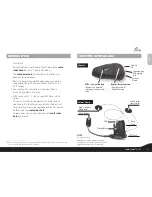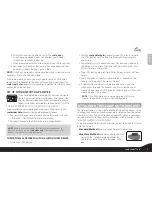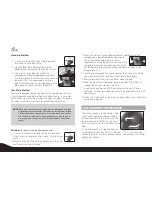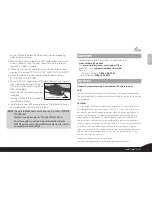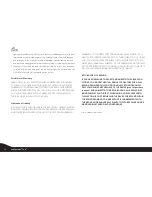
En
glis
h
9
scala rider
®
Solo
™
on the MP3 cable holder should be fixed into corresponding
indentations on clamp.
3. Place the Back Plate on top of the MP3 cable holder and secure
all parts together using the Allen screws that were previously
removed, as shown in photo.
4. Attach the clamp and headset onto your helmet as described
previously in section “ATTACHING THE CLAMP ON THE HELMET”.
5. Attach the speakers to your helmet as described in section
”POSITIONING THE SPEAKERS”.
Insert cable in hook
6. Connect the MP3 cable to your MP3 player device’s jack and the
other side to the helmet Clamp’s
jack, inserting the cable through the
MP3 cable holder.
Make sure that the cable plug clicks
into place.
7. Tuck the MP3 cable into the hook of
the MP3 cable holder.
8. In order to use your MP3 player, power on the headset to have it
on Standby mode, flashing slowly in Blue.
NOTE:
Operate the MP3 Player device by using its buttons (FF/REW/
PLAY/PAUSE).
Volume can only be adjusted through the MP3 Player.
Any other audio connection will automatically mute the
MP3 Player. The audio signal will return only when headset is
once again in Standby mode.
SUPPORT
For additional information please visit our website at
www.cardosystems.com
FAQ:
www.cardosystems.com/support/faq
or contact us at:
support@cardosystems.com
Phone:
USA and Canada:
+ 1-800-488-0363
International:
+4989 450 36819
NOTICES
Federal Communications Commission (FCC) Statement
15.21
You are cautioned that changes or modifications not expressly approved by
the part responsible for compliance could void the user’s authority to operate
the equipment.
15.105(b)
This equipment has been tested and found to comply with the limits for a
Class B digital device, pursuant to part 15 of the FCC rules. These limits are
designed to provide reasonable protection against harmful interference in
a residential installation. This equipment generates, uses and can radiate
radio frequency energy and, if not installed and used in accordance with
the instructions, may cause harmful interference to radio communications.
However, there is no guarantee that interference will not occur in a particular
installation. If this equipment does cause harmful interference to radio or
television reception, which can be determined by turning the equipment off
and on, the user is encouraged to try to correct the interference by one or
more of the following measures:
• Reorient or relocate the receiving antenna.
• Increase the separation between the equipment and receiver.



